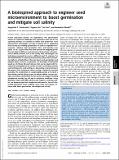A bioinspired approach to engineer seed microenvironment to boost germination and mitigate soil salinity
Author(s)
Zvinavashe, Augustine T; Lim, Eugene; Sun, Hui; Marelli, Benedetto
DownloadPublished version (1.244Mb)
Publisher Policy
Publisher Policy
Article is made available in accordance with the publisher's policy and may be subject to US copyright law. Please refer to the publisher's site for terms of use.
Terms of use
Metadata
Show full item recordAbstract
© 2019 National Academy of Sciences. All rights reserved. Human population growth, soil degradation, and agrochemical misuse are significant challenges that agriculture must face in the upcoming decades as it pertains to global food production. Seed enhancement technologies will play a pivotal role in supporting food security by enabling germination of seeds in degraded environments, reducing seed germination time, and boosting crop yields. So far, a great effort has been pursued in designing plants that can adapt to different environments and germinate in the presence of abiotic stressors, such as soil salinity, heat, and drought. The technology proposed here seeks a different goal: To engineer the microenvironment of seeds by encapsulation, preservation, and precise delivery of biofertilizers that can boost seed germination and mitigate abiotic stressors. In particular, we developed a biomaterial based on silk fibroin (S) and trehalose that can be mixed with rhizobacteria and applied on the surface of seeds, retrofitting currently used techniques for seed coating, i.e., dip coating or spray drying. A micrometer thick transparent robust coating is formed by material assembly. The combination of a polymorphic protein as S and of a disaccharide used by living systems to tolerate abiotic stressors provides a beneficial environment for the survival of nonspore forming rhizobacteria outside the soil and in anhydrous conditions. Using Rhizobium tropici CIAT 899 and Phaseolus vulgaris as working models, we demonstrated that rhizobacteria delivered in the soil after coating dissolution infect seedlings’ roots, form root nodules, enhance yield, boost germination, and mitigate soil salinity.
Date issued
2019-11Department
Massachusetts Institute of Technology. Department of Civil and Environmental EngineeringJournal
Proceedings of the National Academy of Sciences of the United States of America
Publisher
Proceedings of the National Academy of Sciences
Citation
Augustine T. Zvinavashe, Eugene Lim, Hui Sun, Benedetto Marelli, A bioinspired approach to engineer seed microenvironment to boost germination and mitigate soil salinity, Proceedings of the National Academy of Sciences Dec 2019, 116 (51) 25555-25561
Version: Final published version
ISSN
1091-6490